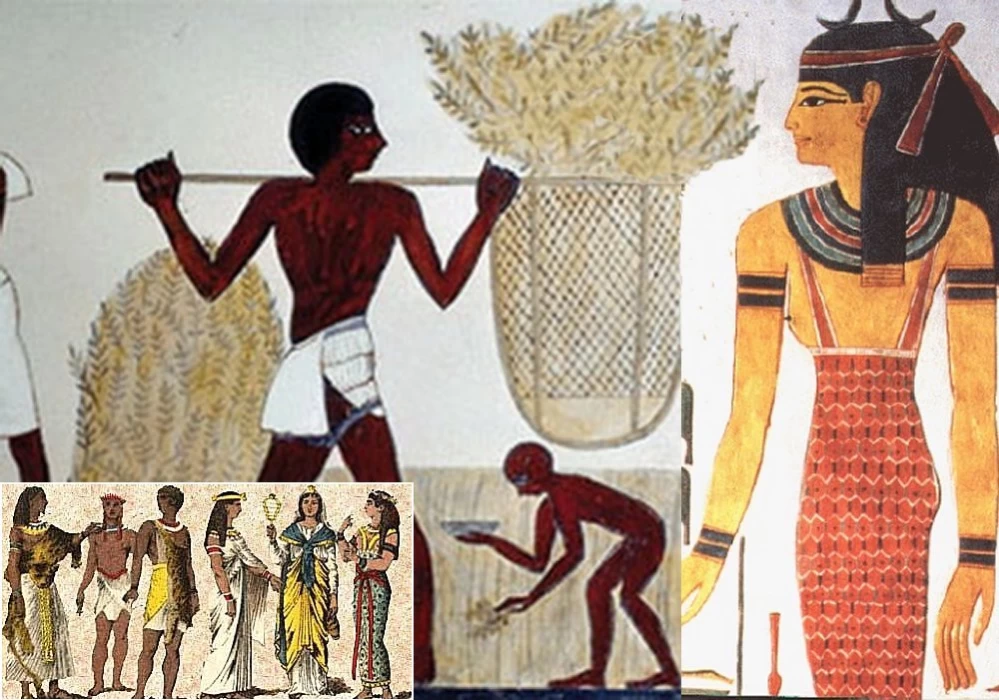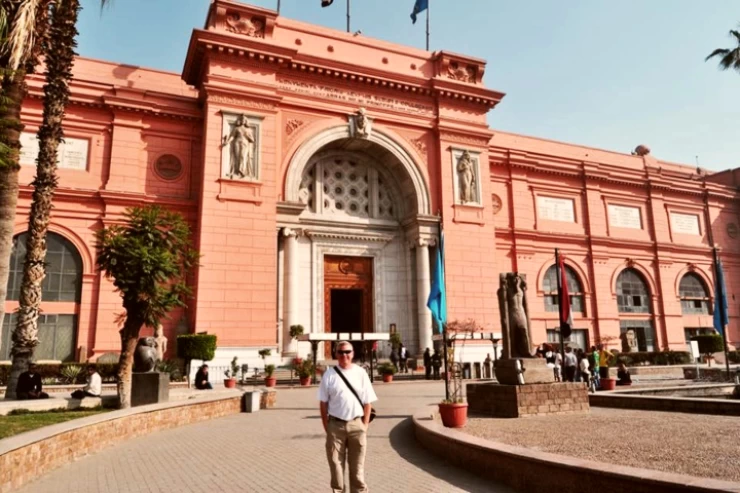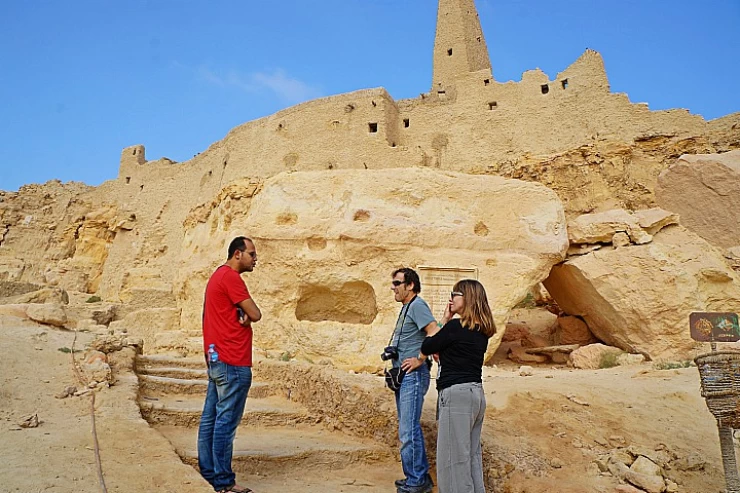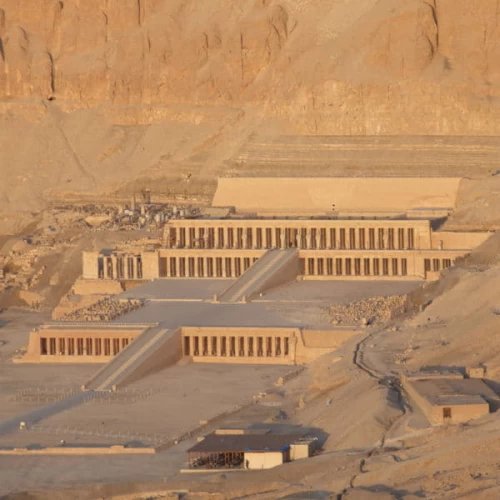
L'abbigliamento nell'antico Egitto
L'abbigliamento nell'antico Egitto
L'abbigliamento dell'antico Egitto si riferisce agli abiti indossati dagli egiziani nell'antico Egitto dalla fine del periodo neolitico (prima del 3100 a.C.) al crollo del regno tolemaico alla morte della regina Cleopatra nel 30 a.C. circa, dove l'abbigliamento egiziano era pieno di una varietà di colori e tessuti diversi che si distinguono con pietre preziose e gioielli preziosi adornati con loro, i costumi degli antichi egizi erano realizzati non solo per la bellezza ma anche per il comfort. La moda egiziana è progettata per mantenere il corpo fresco mentre si è nel deserto caldo
Il lino, il tessuto più comune che descriveva l'abbigliamento dell'antico Egitto, era il tessuto più popolare. Ha aiutato le persone a essere più fresche nel caldo subtropicale che stava accadendo. Il lino è ottenuto dalla pianta del lino filando le fibre dal gambo della pianta. La filatura, la tessitura e il cucito erano un modo molto importante per tutte le società egiziane. È stato possibile normalizzare i coloranti vegetali sui vestiti, ma per lo più hanno lasciato i vestiti nel loro colore naturale. Si conosceva anche la lana, ma era considerata impura. Solo i ricchi indossavano le fibre animali che erano oggetto di tabù. A volte era usato per i cappotti delle donne ma era proibito nei templi e nei luoghi sacri.
Lavoratori, contadini e altre persone di modesta condizione sociale non indossavano sempre nulla, ma indossavano Shinta (di lino) da tutte le persone. Gli schiavi lavoravano spesso nudi, il copricapo più comune era anche considerato khat o a base di erbe, un panno a strisce è indossato dagli uomini
Durante l'era delle Piramidi o dell'Antico Regno dal 2130 a.C. circa, gli abiti erano molto semplici, poiché gli uomini indossavano avvolgimenti intorno alle gonne conosciute come Shendyt, che erano legate in vita, e avevano anche altre forme come a volte piegate o raccolte nella parte anteriore. Durante questo periodo le gonne degli uomini erano corte. Venne anche nell'era del Medio Regno (1600 a.C.), poiché indossava la gonna per un periodo più lungo. Poi avvenne intorno al 1420 a.C., c'era una giacca leggera o una camicetta a maniche lunghe, oltre a un vestito da donna piegato.
Durante le epoche dell'Antico, del Medio Regno e del Nuovo Regno, le donne egiziane per lo più indossavano un abito semplice descritto come kalasiris. L'abbigliamento femminile nell'antico Egitto era più conservatore dell'abbigliamento maschile, poiché gli abiti erano fissati da una o due cinghie e indossati alla caviglia, mentre il bordo superiore poteva essere fissato alla parte superiore del seno, la lunghezza del vestito era considerata un'indicazione della classe sociale di chi lo indossa. Ha usato perline o piume anche per svolgere il suo ruolo nella decorazione del vestito durante il vestito, le donne sceglievano di indossare scialli, mantelle o vesti. Lo scialle era un panno di lino fine largo circa 4 piedi e lungo 13 o 14 piedi. Dove era indossato principalmente pieghettato.
I bambini non indossavano vestiti fino ai 6 anni. Una volta compiuti i sei anni avevano il diritto di indossare indumenti per proteggerli dal clima secco. Un'acconciatura comune tra i bambini era la ciocca laterale, una lunghezza di capelli non rasata sul lato destro della testa. Anche se i bambini normalmente non indossavano vestiti, indossavano gioielli come cavigliere, braccialetti, colletti e accessori per capelli. quando sono cresciuti, indossavano le stesse mode dei loro genitori.
Parrucche
Le parrucche hanno svolto un ruolo importante nella moda degli antichi egizi, in particolare i re e sovrani dell'Egitto e i ricchi di loro e di entrambi i sessi, poiché avevano più di un metodo per realizzarlo, a volte era fatto con capelli umani potrebbe essere integrato con fibre di palma da dattero, ed è spesso progettato in riccioli stretti e trecce strette. Era indossato da donne e uomini in occasioni speciali, e sia uomini che donne possono completare le parrucche con coni di grasso profumato che si sciolgono per liberare l'odore del profumo e dell'acconciatura.
Gioielleria
Indipendentemente dalla classe sociale, se era povera o ricca, i gioielli erano molto popolari nell'antico Egitto, erano pesanti e un po 'ingombranti. La ragione principale per indossare gioielli è a causa della sua funzione estetica, proprio come gli antichi egizi indossavano abiti sobri in tessuti di lino bianco. La preferenza egiziana era per l'uso di colori vivaci, pietre lucenti e metalli preziosi, come quei capolavori del re Tutankhamon esposti nel Museo Egizio del Cairo, che è realizzato su misura con materiali egizi come l'oro estratto dal deserto orientale dell'Egitto, e proveniva anche dalla Nubia, che fu per secoli una colonia egiziana.
D'altra parte, l'argento era raro e veniva spedito dall'Asia. Pertanto, era l'argento che era regolarmente considerato più prezioso dell'oro. Il deserto orientale era anche una fonte essenziale di pietre semipreziose colorate come la corniola, l'ametista e il diaspro. Nel Sinai c'erano miniere turchesi, il lapislazzuli blu profondo doveva provenire dal lontano Afghanistan. Il vetro e la maiolica (smalto su un nucleo di pietra o sabbia) erano i preferiti per sostituire le rocce perché potevano essere prodotti in diversi colori.
Il nostro team vi aiuterà a viaggiare in Egitto e sperimentare il tempo soleggiato del nostro bel paese durante la Pasqua, grazie alla loro vasta conoscenza del turismo egiziano. Puoi personalizzare il tuo pacchetto selezionando uno dei nostri pacchetti di viaggio in Egitto o sfruttare al massimo il tuo tempo in una breve visita, imparando di più sulla storia egiziana e le sue affascinanti storie e vivendola attraverso tour privati al Cairo. Partecipa a uno dei nostri tour economici in Egitto attraverso il deserto del Sahara, come i tour di Siwa dal Cairo, per esempio, o preferibilmente i tour nel Deserto Bianco d'Egitto. Scoprite i nostri tour di un giorno ad Assuan, fate una gita di un giorno da Assuan ad Abu Simbel, o viaggiate via terra e godetevi i nostri tour di un giorno a Luxor per vedere gli incredibili templi di Karnak, il Tempio di Luxor, il Tempio di Hatshepsut, e vedete le meravigliose tombe splendidamente dipinte nella Valle dei Re, questo è il luogo dove i re e i governanti del nuovo regno riposano in pace e imparate i loro riti di mummificazione e sepoltura.
A Brief Analysis of Policy, Cultural, and Historical MilieusThe costumes of ancient Egypt carry an immense weight in comprehending the social, cultural, and religious relations of one of the most complex civilizations in the world. Clothing played an essential role in the lives of the ancient Egyptians; it was not worn solely to cover the body. Rather, it signified social class, sex, occupation, and religion, all of which were in harmony with the surroundings and the sophisticated civilization that the people of the Nile River developed.
Linen is the Fabric of Choice in the ancient Egyptian clothes.
In ancient Egypt, one of the most popular and numerous textiles was the flax linen, which was predominantly cultivated along the banks of the Nile. The high temperatures in Egypt made it unavoidable to wear light and porous materials; hence, linen became the most appropriate material to use. All the same, the process of making linen from the flax plant was rather labor-intensive because it involved soaking the plant, pounding it down to retrieve fewer strands of it, and finally, yarn coming from those strands.
Zibellina esdromis fine-quality linen was especially popular with the nobles’ elite. The most advanced, termed "palace linen," was quite light but stable, glossy, and a bit transparent, indicating that it was designed for the affluent class. Nobility and priests, including the pharaohs, wore the most delicate and immaculate white linen attires, which were also for royalty due to their unblemished look and spiritual aspect, while the lower class dressed in the most tattered and coarse fabrics.
The clothing worn by the elite reflected their position, riches, and belief in their godliness. As earthly gods, the Queen and Pharaoh donned fashionable elements of clothing infused with various images. One of the most popular items of clothing worn by the pharaoh was the'shendyt’, a tailored pleated skirt that was extended with both gold and gem decorations. It was held in place by a decorative sash and, at times, was worn with a beautifully crafted robe or jacket for events.
Pharaohs also had a piece of headgear that was almost a statue of a king, called the ‘names’, which is a striped fabric wrapped around the head and tied at the back. All three, together with the false beard, the headdress of a king, and crowns with either the white or red crown of Egypt or the double crowns of Egypt—a sign of authority and power, only that it was royal power.
They wore clothes similar to those of the pharaoh but not as ostentatious. Richer men and women wore complex necklaces that included gold and colored stones. Their dresses were elaborately designed to exhibit their social class, with women frequently dressing in body-hugging sheaths made out of quality linen.
As the elites displayed their opulent clothing, the vast majority of the Egyptian population, consisting of farmers, laborers, artisans, and servants, put on simpler clothes. Working-class men were mostly found dressed in a simple loincloth or a knee-length coarser linen kilt. The tunic dresses worn by women were no exception and were specially designed to facilitate a woman's domestic and daily activities.
In spite of having simple clothing, it was clear that they took time and effort in the way they looked. The cleanliness and general appearance of the Egyptians of all social classes were important, and this can be attributed to the fact that they applied perfumes, oils, and cosmetics on a daily basis as part of their dressing code.
Religious and ceremonial costumes
Religious beliefs and practices permeated every aspect of daily life in ancient Egypt; hence, the costumes worn during religious and ceremonious activities depicted the outlook of the society. To express their sanctity and the god’s role they were playing, priests wore linen white robes. Most high priests were draped in leopard-skin cloaks, which were worn around the robe’s bust region during the ceremony to indicate closeness to the gods.
Dresses of deities were often characterized by very elaborate and expensive garments, with some, like goddess Hathor, even dressed in detailed sheath dresses. The meaning behind the use of practical animal skins and feathers, as well as ornamental pieces, was to call for the presence of divine beings and their goodwill.
Moreover, no attire in ancient Egypt would be complete without the inclusion of ornamental pieces. For the ancient Egyptians, jewelry had a purpose beyond mere decoration; it was considered to be a protective talisman worn against dark forces. Everyone, regardless of rank, embellished and decorated themselves with intricate pieces of jewelry, such as neckpieces, ear decorations, wrist and ankle covering ornaments, and even finger bands.
Rings, earrings, necklaces, and other kinds of jewelry were usually very expensive things because they were made from gold and other precious stones for the rich class, whereas the lower class spent less on ornamental copper, bronze, or colored glazed beads.
In the history of mankind, when different civilizations have flourished and left behind valuable artifacts, amulets have also been widely utilized among the ancient Egyptians. They were not merely decorative charms worn on a necklace or a bracelet, which was the fashion of the day; they also represented gods, animals, and other holy things believed to give protection in life and death.


















